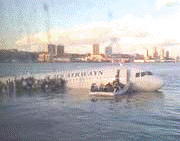Bird Strike Committee Proceedings

Bird Strike Committee-USA/Canada Joint Annual Meeting: 10th (2008)
Date of this Version
8-2008
Document Type
Article
Abstract
Aircraft-bird strikes present a significant safety hazard to military aviation. The USAF began researching small mobile radars (SMRs) in the late-1980’s to provide close-in detection and tracking of hazardous bird activity on and around military airfields. Lessons learned from early field studies validated the ability of marine radar to detect and track birds, but identified requirements to automate detection and tracking for operational use. The first airfield to deploy a SMR for real-time bird detection for air traffic control was the Royal Air Force (RAF) base Kinloss in Scotland which installed a Geo-Marine MARS unit in 2002. Validation of the operational efficacy of the system was conducted by the RAF and the Central Science Lab (CSL); the MARS system has since been in continuous operational use by RAF Kinloss controllers. The first operational USAF SMR for bird detection was installed at the Dare County Range in North Carolina in 2003. The system, a DeTect MERLIN XS2530m, is a dual horizontal and vertical fan beam radar configuration that is used on approximately 90% of the avian radar systems in operation at present worldwide. In 2007, the USAF deployed an upgrade to the SMR radar system software that continuously monitors the runway and runway approach and departure corridors, automatically determining and displaying the current bird strike risk on the radar screen and via other information systems. The SMR today has moved from a development project into an operational tool for selected USAF installations. On-going work within the program includes deployment of improved performance features and expanded functionality as developed by the SMR vendors based on user feedback and experience gained on operational systems. The BASH Team is additionally coordinating and supporting service-wide certification efforts for integration in control procedures, frequency approvals and third-party software use on DoD networks, as well as defining a concept of operations (CONOPS) for forward-based deployment of the systems to support military theatre operations.


Comments
Abstract of paper presented at Bird Strike Committee USA/Canada Meeting, Lake Mary and Sanford, Florida, August 18–21, 2008.